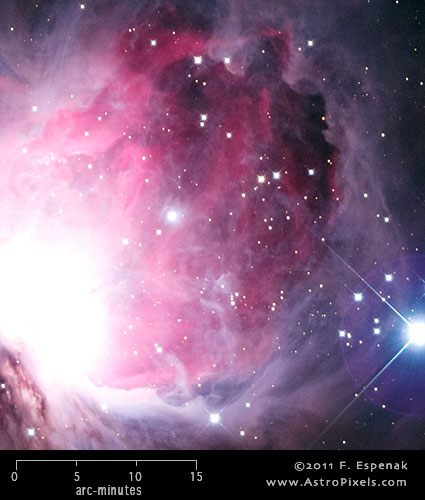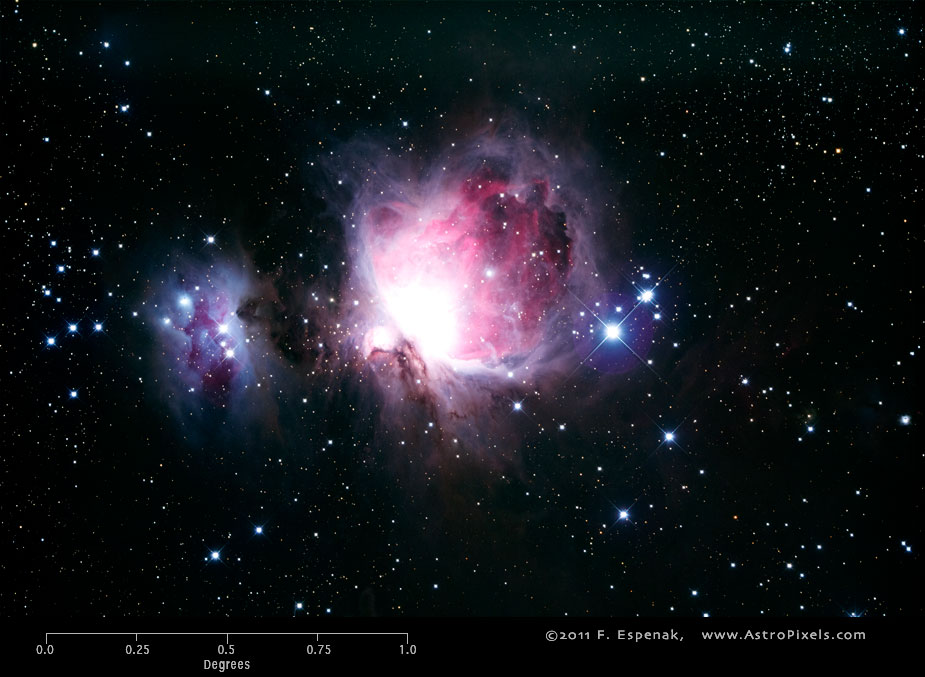
M42 - Orion Nebula
Messier 42 or M42 (also designated NGC 1976) is a nebula in the constellation Orion. It has an apparent visual magnitude of 4 and its angular diameter is 85x60 arc-minutes. M42 lies at an estimated distance of 1600 light years. The Equinox 2000 coordinates are RA= 5h 35.4m, Dec= -05° 27´ which makes M42 best seen during the winter. The Messier Winter Star Chart shows the position of all Messier objects visible during that season. As one of the more famous objects in the Messier Catalog, it is commonly known as the Great Orion Nebula.
M42, the Great Nebula in Orion is a complex region of active star formation where some of the hottest and brightest stars are coalescing. Composed of glowing gas and dark dust, this nebula is part of the much larger Orion Molecular Cloud Complex.This immense region also includes M78 and the Horsehead Nebula located south of Zeta Orionis (Alnitak), the easternmost star in the Belt of Orion.
The red glow visible in the Orion Great Nebula is characteristic of ionized hydrogen as it recombines with lost electrons. Embedded deep in the nebula is the Trapezium - a tight group of four of the brightest stars in M42. The Trapezium can be seen in a small telescope but the Great Nebula is visible to the naked eye as a fuzzy patch and has an integrated apparent visual magnitude of +4.0. The Great Nebula lies in the Orion Arm of the Milky Way Galaxy at a distance of about 1300 light years.
Just to the north of M42 is M43, a teardrop shaped emission nebula that appears separated from M42 by a dark dust lane in the foreground. However, M43 is physically part of the Great Nebula.
The blue nebula north of M42 is an interstellar cloud of dust reflecting light from hot young stars. It is composed of three regions known as NGC 1977, NGC 1975, and NGC 1973. Physically associated with the Great Nebula, it lies at about the same distance.
The image above shows the uncropped view of M42 (and M43) through the Takahashi E-180 Astrograph (North is up). A 2x enlargement of this image appears to the right.
In spite of its inclusion in the Messier Catalog, this diffuse nebula was actually discovered by Peiresc in 1611. According to Kharchenko et al. (2005), the distance of the M42 is 1300 light years and its diameter is 4 light years. It contains >300 stars and its estimated age is 0.1 million years.
For more information, see the Messier Catalog as well as specific entries for M42 in Wikipedia and SEDS.
Messier's Description of M42
March 4, 1769
`Position of the beautiful nebula in the sword of Orion, around the star Theta which ii contains [together] with three other smaller stars which one cannot see but with good instruments. Messier has entered into the great details in this great nebula; he has created a drawing, made with the greatest care, which one can see in the Memoirs of the Academy for 1771, plate VIII. It was Huygens who discovered it in 1656: it has been observed since by many astronomers. Reported in the English Atlas Coelestis.'
Technical Details
- Object: M42
- Other Names: NGC 1976, Great Orion Nebula
- Object Type: nebula
- Object Data: Apparent Magnitude = 4, Angular Size = 85x60 arc-minutes
- Object Position (Equinox 2000): RA= 5h 35.4m, Dec= -05° 27´, Constellation = Orion
- Date/Time: 2011 Feb 23 at 04:53 UTC
- Location: Bifrost Astronomical Observatory, Portal, AZ
- Mount: Astro-Physics 1200GTO
- Telescope: Takahashi Epsilon 180 Hyperbolic Astrograph
- Camera: Canon EOS 550D (Rebel T2i) (modified with a Baader UV/IR filter)
- Field of View: 1.70° x 2.56° at 1.7 arc-sec/pixel (web version: 10.0 arc-sec/pixel)
- Exposure: 28 x 300s, f/2.8, ISO 800
- File Name: M42-01w.jpg
- Processing (Adobe Camera Raw): Graduated Filter, Vignetting Correction, Noise Reduction, White Balance, Curves
- Processing (Photoshop CS5): Average Images, Curves, Noise Reduction
- Original Image Size: 3454 × 5179 pixels (17.9 MP); 11.5" x 17.3" @ 300 dpi
- Rights: Copyright 2011 by Fred Espenak. All Rights Reserved. See: Image Licensing.
